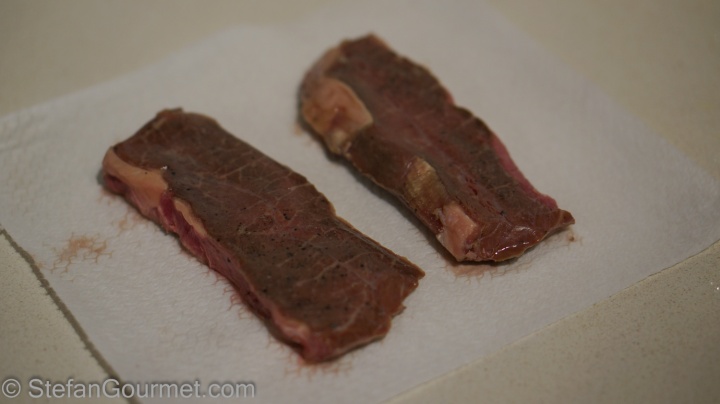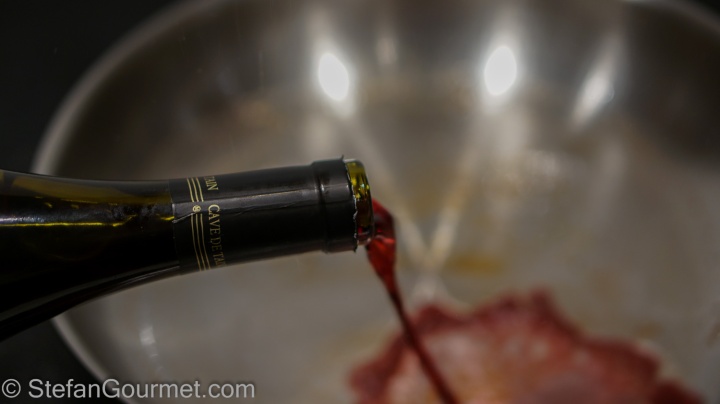
Beef shoulder, also known as the top blade roast, has great marbling (intramuscular fat) and therefore great flavor. It has a drawback, which is a thick central muscle sheath that is very tough. If that sheath is removed then the resulting cut is called flat iron steak (in the US; butlers’ steak in the UK, oyster blade steak in Australia/NZ), but that steak is tougher because it is not cut against the grain. When cut across the grain, the resulting cut is called (top) blade steak and that is what you see in the picture. In the Netherlands this is known as sukadelappen, because when you braise this cut then the sheath will end up with a texture that reminds one of candied citron (called sukade in Dutch). Although blade steak is more tender than flat iron steak because it is cut across the grain, it does have the thick and tough muscle sheath in the center that doesn’t make it very suitable to be served as a steak. Unless of course you cut out the muscle sheath and glue the meat back together with transglutaminase. And that is exactly what I did 🙂

I wrote already how you can save money with sous-vide by buying cheap tough cuts and turning them into a tender juicy steak by slow and precise cooking. The sukadelappen shown in the first picture were on sale for only 8 euros per kilo (US$ 4.50/lb). Notice the great marbling? Cooked sous-vide for only 12 hours at 55ºC/131ºF it became just like a rib eye steak (or perhaps even better) that would cost 30 euros per kilo. Notice how nicely pink the meat is all the way to the edge? Here’s how I managed that.

First I cut out the central muscle sheath.

Then I made a slurry of transglutaminase (Activa RM/EB) and cold water.

I brushed the cut edges with the slurry…

…and I reconstructed the steaks.

Then I seasoned them with salt and freshly ground black pepper, and vacuum sealed them.

I cooked them sous-vide for 12 hours at 55ºC/131ºF. (This means by the way that the meat will be pasteurized and save to serve to a pregnant woman, even though it is medium rare.)

Then I took the steaks out of the sous-vide bags and patted the steaks dry with paper towels, reserving the juices from the bags.

I seared them very briefly (less than a minute per side) in clarified butter over very high heat. Clarified butter gives better flavor, better browning, and less splattering than oil and it doesn’t burn like regular butter would.

The browning after sous-vide cooking has three purposes: it looks better, it adds flavor, and it heats up the outside of the steak so it won’t cool off as quickly. (This is important with meat that is cooked sous-vide, as it is only 55ºC/131ºF to begin with, which is not that hot.)

I wrapped the meat in aluminum foil to let it rest, and I poured most of the fat out of the frying pan. Then I deglazed the pan with red wine, scraping with a wooden spatula to get the nice brown bits from browning the meat into the sauce.

I cooked this over high heat, stirring, until…

…it was a nice and thick sauce. Since I was aiming for a thick and dark sauce, there was no need to worry about adding the sous-vide bag juices to the sauce.

I served the steaks on preheated plates with the sauce and sprinkled with a bit of coarse salt.
Wine pairing
Beef with such a full flavor and strong sauce can handle a pretty hefty red wine without a lot of oak from new barriques such as a Shiraz/Syrah, a Bordeaux, a Barolo or a red from the South of Italy.
Flashback

This ginger and honey ice cream is Kees’ favorite homemade ice cream flavor, so I keep making it. The candied ginger that is required for it is available in every Dutch supermarket, but may be more difficult to find elsewhere. I should probably try to make my own candied ginger and post the recipe…




Finalmente ho scoperto come cuoci sottovuoto. Ma i sacchetti sono quelli normali?
LikeLike
Mi racommando di leggere questo: http://stefanobuongustaio.com/2013/04/12/che-cose-la-cottura-sottovuoto/
I sacchetti normali vanno bene, però è meglio se siano adatti per cucinare (temperaturi alti).
LikeLike
Oh, non so se qui al paesello si troveranno. Grazie per il link!
LikeLike
Perfectly cooked steak and love the thick sauce!
LikeLiked by 1 person
Another excellent example of sous vide cooking at its finest.
LikeLiked by 1 person
You have a post elsewhere on this site about adding Sous Vide bag juices to a sauce – and some very helpful instructions about how to deal with the ‘scum’ that forms. Why is that not a problem in this recipe?
If one was to Sous Vide this cut of meat without your surgical and gluing magic – can you comment on how much one should lengthen the process – or would the part that you have cut away preclude this?
LikeLike
Good questions!
I do not understand exactly why the ‘scum’ is not a problem in some cases. For instance, when I cook meat in a teriyaki marinade there is no scum when I reduce the marinade after sous-vide cooking for the sauce. In this case, the sauce is so dark and thick that I didn’t notice the scum. But I was still surprised it turned out so well.
I have done two posts on blade steak without removing the tough sinew in the center of the meat.
One simply leaves it in, which means the diners will have to eat around it (not suitable for entertaining guests):
https://stefangourmet.com/2014/03/25/wagyu-blade-steak-sous-vide-with-caramelized-red-onions/
The other is to use a much higher temperature so the tough sinew will break down and become tender. This is basically the same as a regular braise, but I did it sous-vide anyway as an experiment and I thought it made it easier (more consistent results and no need to watch it while it is cooking): https://stefangourmet.com/2014/01/05/braised-flat-iron-steak-with-parsnip-fondant-draadjesvlees/
LikeLike
nope, you shouldn’t discard the middle sinew, it’s transforn into tender collagen once sousvide at least 8 hours
LikeLike
At what temperature?
LikeLike
i’m using my rice cooker waterbath, it’s fluctuated between 58-60 C
LikeLike
This looks phenomenal! I bought a 2.5lb blade roast and would like to sous vide it whole. Would the cooking time be significantly longer? 24-36hours? Thanks!
LikeLiked by 1 person
Hi Jacqueline, the cooking time is about the same, perhaps a couple of hours longer. It takes about 4 hours for the core of the roast to reach 55C/131F (this depends on the thickness and shape of the roast). I wouldn’t cook it longer than 16 hours, because the meat will become too tender (mushy) when held at 55C/131F for too long. Hope this helps; let me know if you have further questions.
LikeLike
Thank you for the quick reply! I have started and set at 135f and cut off a piece at 17hr mark and still steak-like with chew (more than I’d like). I understood that blade roasts are tough cuts and therefore categorized with the same cooking time (24-36hrs) as brisket. I also did not remove any tissue as you have in your recipe. I’m thinking of maybe going a couple more hours. What do you think?
LikeLike
Your blade roast must be tougher than ours. If it was still tough, you may need more than a couple of hours. I do brisket for 48 hours at 135F.
LikeLike
Thanks Stefan! I cooked it for 24hours and it turned out nicely. I think it could have probably gone for a bit longer 36-48hrs to be a bit more tender. 😊
LikeLiked by 1 person
Hi Stefan: Just tasted it, absolutely great ! I left in the middle sinuw. It was (almost) gone. Perfect medium rare. Even my wife looked at it and said: damn… and she is a vegetarian. Maybe you can give some instructions for the sauce. I did a little bit of this and an little bit of that, and it tasted not bad but, maybe it can be better 😉 Thanks a lot !
LikeLiked by 2 people
Followed your approach with a featherblade, 12 hours at 55, accompanied by a fillet which had 1 hour at the same temp… was really difficult to pick a winner. Both were superb.
LikeLiked by 1 person
Great, thanks for reporting back!
LikeLike
Are u not worried about the risk of bacteria when cooking beef at 55°C for more than 2.5hrs?
LikeLike
No I am not worried at all. In fact, it becomes safer the longer you cook it at 55C. For more information, read this: https://stefangourmet.com/2016/11/27/understanding-food-safety/
LikeLike